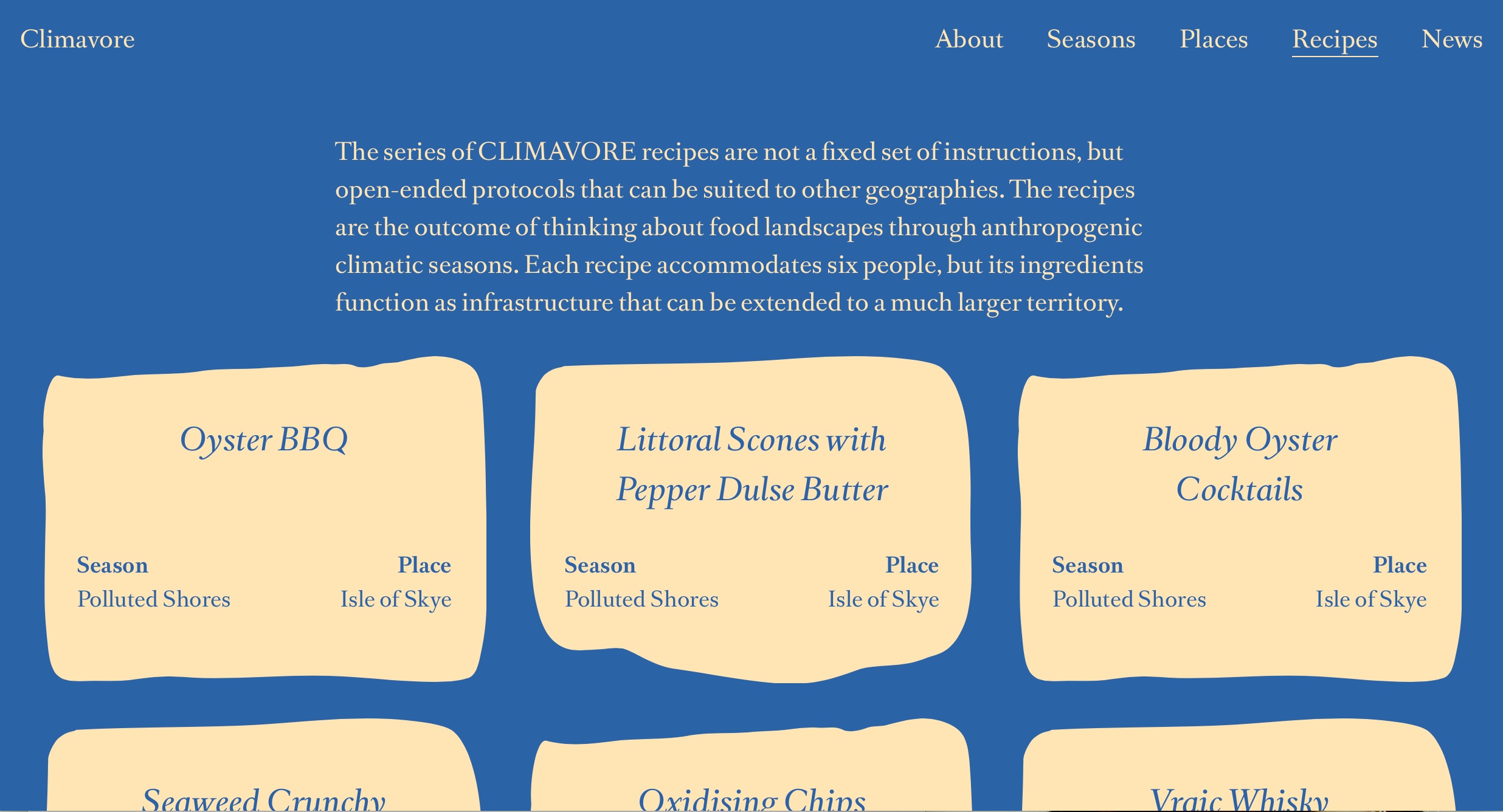Art Initiatives
A blog and collection of resources for artists, gathering together organisations, actions, installations
Zero-Waste Art Installations and Exhibitions
Zero-Waste Artist: Todd Bank
Project Team: WASTE ART-Southern California, Todd Bank-Founder
As part of their mission to educate urban communities about contemporary recycle/reuse art methodologies, WASTE ART implement’s temporary zero-waste art installations in major metropolitan areas. Their art projects consist mostly of found-free post-consumer waste materials to communicate a message that promotes sustainability.
The main objectives of WASTE ART’s installations are as follows: (1) to provide opportunity for everyday people to gain an appreciation for waste material issues including economic, social, and environmental factors, and the sustainability issues urban communities face in the near and distant future. (2) To entertain an “Open-Minded” public-art audience with all the brilliant textures and colors of post-consumer waste.
Furthermore, WASTE ART’s goals are to educate their audience about the damage waste materials deposited in landfills are doing to the planet’s atmosphere and environment as well as to promote overall local sustainability and environmental footprint knowledge. Most importantly, their zero-waste art installations are not “Doom and Gloom” exhibitions. WASTE ART wants everyone to leave their events happy and with hope for a better world in the future!
Mini-Museumnight 8 Nov - Green Masquerade Edition.
www.arti.nl/activiteit/pleuriversum-x-global-warm-up-2/
PLEURIVERSUM
Nov 2 - 15, 2019
Amsterdam
In 'Pleuriversum' all makers and speakers play with the issue of global ecological threats and the current climate debate. We look at our planet as a closed system in which small changes in one place can also have an effect elsewhere - positive or negative.
From the visual arts, social design, performance art, fashion, philosophy, literature and science, the art manifestation is set up as an ecological system in itself. Starting with our own body as a self-regulating cycle, increasingly zooming in on the world around us, the manifestation meanders throughout the entire Arti building as one sensory laboratory. With stimulating ideas and playful, surprising insights from cultured meat ice cream and beauty articles from body juices, to a Groningen ditch and its inhabitants, European lobby in pulse fishing and the consequences of nuclear disaster Fukushima.
Artists: Isabel Burr Raty (CL/BE) | Thomas Thwaites (UK) | Pink Pony Express (VS/NL) | Koos Buist (NL) | Esther Kokmeijer (NL) | Marwan Moujaes (LB) | Tinkebell (NL) | Madison Bycroft (AU) & Angelica Falkeling (SE) | Next Nature (NL) | Global Warm Up (FR/PE/IT/DE) | Kalan Sherrard (VS) | Iekeliene Stange (NL) & Ibelisse Ferragutti (BO) | Schwierige Franz (NL) | Talking Trees (NL) | Abel Kroon (NL)
Concept en samenstelling | Arjen Lancel & Merel Noorlander
Call: City as living laboratory
CALL’s mission is to raise environmental awareness and promote the sustainable development of urban communities through the arts.
Our artist-facilitated programs are conceived to help citizens connect environmental challenges to personal experience and take action to find solutions for concrete improvements. CALL supports interdisciplinary collaborations with scientists, urban planning experts, key community actors, and government officials.
This is what climate change sounds like
Daniel Crawford was so inspired by his work turning climate data into a musical piece that he’s now in graduate school studying climate.
Institute on the Environment, University of Minnesota/YouTube
Scientists often state that the planet has warmed by 1 degree Celsius (1.8 degrees Fahrenheit) since 1850. But the weather from year to year varies. It’s hard to grasp just what one degree of overall warming is like.
That’s why Daniel Crawford picked up his cello.
Crawford studies climate at the University of Minnesota in St. Paul. When he was a college student, he worked with Scott St. George, a scientist who studies climate by looking at ancient tree rings. “He had been interested in using music to convey trends in climate change data,” Crawford says. Crawford and St. George started with a data set of surface temperatures beginning in 1880. By matching each yearly temperature change with a musical note, Crawford composed a “song for our warming planet.” As the temperature gets warmer, the notes get higher. The result is a creepy tune. “The maps, the graphs and the numbers are not conveying the message,” Crawford says. He and St. George hope that music might make a difference.
ClimArte
Arts for a safe climate
CLIMARTE harnesses the creative power of the arts to inform, engage and inspire action on climate change.
CLIMARTE is bringing together a broad alliance of arts organisations, practitioners, administrators, patrons and academics from across the spectrum of the arts sector, including the visual arts, music, theatre, dance, literature, architecture, and cinema. By joining this alliance we acknowledge the enormous risks that human induced climate change poses to our world and we commit to advocating for immediate, effective and creative action to be taken to restore a safe climate, capable of supporting a healthy and sustainable environment.
Museum of Water by Amy Sharrocks, London UK.
"Museum of Water is an invitation to ponder our precious liquid and how we use it. Begun in a time of relative plenty in Britain, the Museum is travelling across the world gathering collections of water for future generations to consider. Water is our most basic need and our most overlooked, throwaway substance. We choose water metaphors to define our thoughts, while in our actions we defend against it, squeezing and pumping it, chlorinating and piping, soothed by our certainty that it will pour from our tap at a twist of our fingers. It is time to re-examine our connection with the water that surrounds us, and develop a new relationship. We need to hold on to water, consider what is precious about it and how we are using it now in order to explore how we might save it for the future. We are all implicated in this. Museum of Water has travelled to over 50 different sites worldwide, been visited by over 60,000 people, and currently holds over 1,000 bottles in the collection."
"The Museum is itinerant. We travel because we understand that not everyone can, and we want to hear as many voices as possible. Museum of Water began in London in March 2013 and travelled across the UK for 3 years. It has travelled to different parts of Europe, and was resident across Rotterdam with the Rotterdamse Schouwburg 2014 – 2016. It is currently travelling across Western Australia with Perth International Arts Festival until 2018, after which their collection will be housed permanently with the WA Museum."
"Amy Sharrocks is a live artist, sculptor and film-maker who invites people to come on journeys in which their own experience, communication and expression are a vital part. Undertaking these journeys with a sense of humour, joy and risk, Amy creates work that is rich, unpredictable and different every time. This invitation and the bravery and invention of people’s responses, produces new avenues for exploration and fantastic visions within the everyday. Amy has been making work about people and water for 10 years."
Cape Farewell
"Cape Farewell changes the way we think about climate change"
"In 2001 the artist David Buckland created the Cape Farewell project to instigate a cultural response to the climate challenge. Cape Farewell is now an international not-for-profit programme based in the UK.
Working internationally, we bring creatives, scientists and informers together to stimulate a cultural narrative that will engage and inspire a sustainable and vibrant future society. Using creativity to innovate, we engage artists for their ability to evolve and amplify a creative language, communicating on a human scale the urgency of the global climate challenge.
Our complex societies have evolved dependent of fossil fuel for our energy. It is now proven that carbon dioxide and other emissions from the burning of these fuels is causing potentially devastating damage to our habitat. Our developing Cleantech industries can replace our dependency of fossil fuels and deliver a cleaner, healthier culture.
Cape Farewell asks the best of our creative minds to engage with this challenge and to build a vision for a sustainable future."
Learn more about Cape Farewell here.
Artists & Climate Change
"Through the publication of essays, interviews, and editorials, the blog and international network Artists & Climate Change creates community and promotes the inclusion of the arts in the global climate change conversation. Since its launch in 2013, A&CC has become an educational resource for art, environment, and social change classes."
"Today, interesting artistic work about climate change is popping up all over the world, in all kinds of venues. It shows up in opera houses and hip hop poetry slams, in established galleries and on-the-fly exhibitions, in off-Broadway houses and regional theatres. The goal of this blog is to track these works and gather them in one place. It is both a study of what is being done, and a resource for anyone interested in the subject. We deeply believe that what artists have to say about climate change will shape our values and behavior for years to come. For that reason alone, we should pay attention.
Artists & Climate Change is an initiative of The Arctic Cycle.
Why art has a part to play in tackling climate change
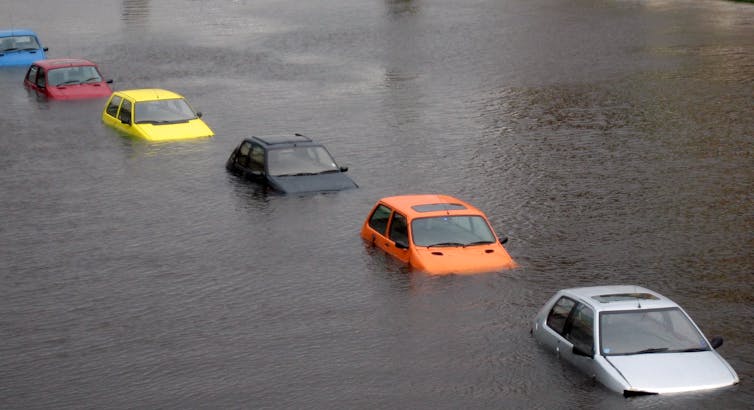
Something needs to be done about climate change, that much at least 196 countries agree on. But as the next weeks, months and years see politicians, scientists and industry thrashing out what the “first comprehensive global treaty to combat climate change” means in practice, we collectively face some tough questions. The wrangling has only just begun.
Alongside an unprecedented number of heads of state, COP21 also witnessed an unprecedented number of artists gathering in Paris for the “conference of creative parties”, ArtCOP21. In doing so, a global network of cultural engagements with climate change was created.
The scientific community increasingly recognises the value of interdisciplinary action in the face of problems such as climate change, and the perspectives of social sciences are increasingly valued. But the prospects of arts and humanities are less often appreciated. As well as the poster-art activism of Brandalism, and the numerous film screenings, art installations, performance works and participatory art activities that took place during the talks, a growing number of arts organisations including Cape Farewell, Julie’s Bicycle and Tipping Point advocate passionately for the value of creative responses to climate change.
So what can art do?
Woolly birds
Knitting is perhaps an unlikely vehicle for connecting people with local climate change. Yet Deidre Nelson’s project Bird Yarns (2011), supported by Cape Farewell, did just that. Nelson worked with communities on Mull and the surrounding Scottish Islands to develop a simple pattern that enables amateur and experienced knitters alike to produce woolly Arctic terns, a species once commonly seen in the islands.
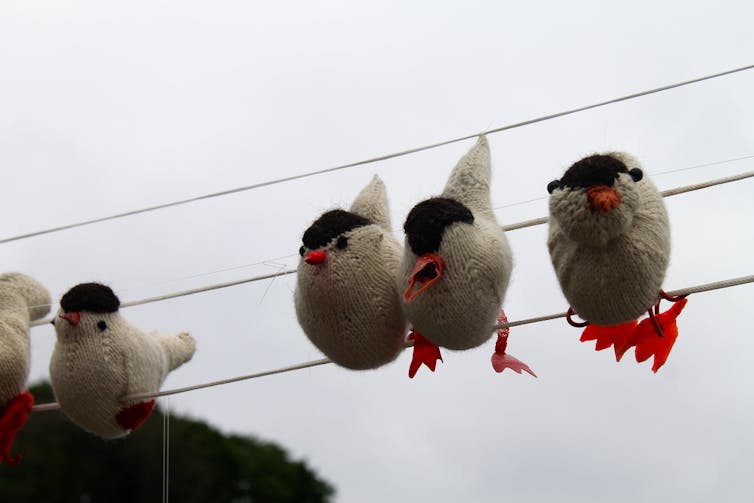
These felted avian forms were eventually displayed, firstly at Tobermory Harbour and eventually at galleries around Scotland. Accompanied by a scientific soundtrack, knitting became a way to tell the story of the tern’s fate under climate change. The birds are increasingly failing to mate and their offspring are starving as shifting ocean circulation patterns break up breeding grounds and threaten food stocks.
Such local stories challenge the dominant Western mascots of climate change: distant geographies of marooned polar bears and melting glaciers calving great chunks of ice into the sea. They challenge the notion of climate change as an abstract science of tipping points, thresholds and boundaries. Artists can bring climate change “back home”, enabling us to sense its effects on our own local places and environments.
Whispering forests
What do the trees sound like? This is a question that Swiss artist Christina della Giustina asked the environmental scientists she worked with during her residency at WSL, the Swiss Federal Laboratory for research into Forest, Landscape and Snow. At WSL scientists use century-long data records concerning atmospheric composition and vegetation health to develop contemporary predictions of environmental change.
Accompanying them into the field and working alongside them in the lab, della Giustina explored how these scientists “know” the trees they study. Her ongoing project You Are Variations (2007- ) encourages alternative ways of knowing, sometimes by setting different registers of visualization alongside one another – from hand drawing to high-resolution images. She also uses participatory art to encourage scientists to engage with the local communities living around the trees they study, and develops sound art that incorporates the sonification of live data streams with orchestral compositions.
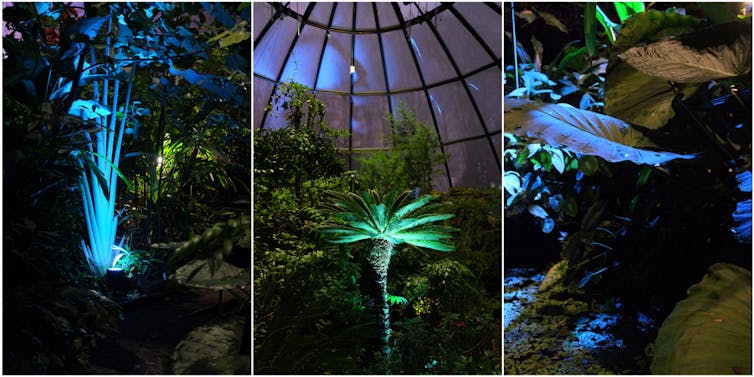
Such multi-dimensional engagement is worlds away from the techno-scientific interpretations of climate change and thus so many of the practices and discourses of climate security that circulate at events such as COP21. But an increasingly large proportion of art about climate change is, like della Giustina’s work, made by artists working in collaboration with scientists. Organisations such as the Swiss Artists-in-Labs place artists in scientific laboratories, giving them access to equipment, techniques and data. Often the result is art that has not only evolved in response to these scientific tools, but that is also critical of the terms upon which scientific knowledge is made.
Amateur science
Amateur scientific practice can have a part to play, too, as in the Thames Estuary project Wrecked: On the Intertidal Zone (2015). The project saw the development of a series of experiments combining myriad ways of knowing the estuary, setting the practices of local bird watchers, fishermen and mud walkers among scientific studies and information gleaned through political and corporate wranglings.
Scientists, it is often assumed, are the climate experts. They are the ones with the information about causes and effects, the strategies for intervention and mitigation. But amateur knowledge is vital, too. Historically, for example, community records and artistic representations have had a key role in environmental reconstructions. More recently, artists have combined participatory practices with citizen science to remake the terms of the production of science. Unseating the singular image of the climate expert they open out a broader sense of who understands and can intervene with our changing environments.
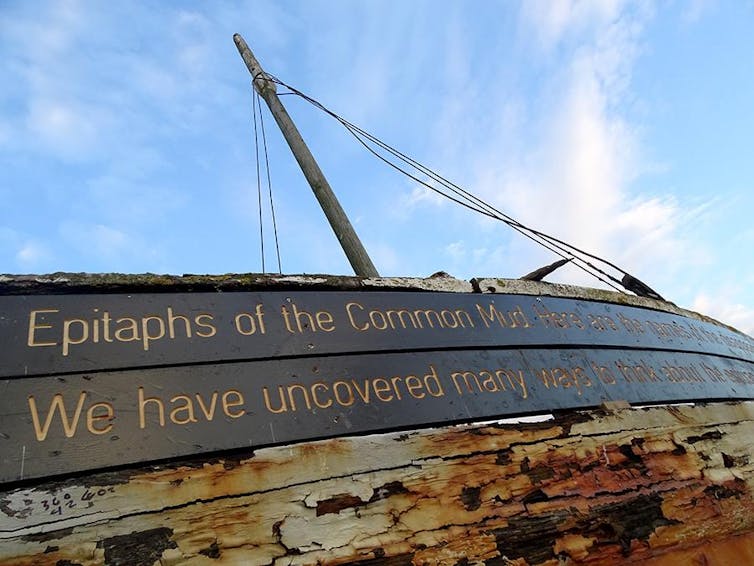
The global nature of the agreement reached at COP21 might mark history, but these promises, inadequate as they are, still need to be translated into action. While climate change remains the preserve of scientific experts, politicians and activists, and while the popular imaginary is dominated by stranded polar bears, confused penguins and cracking ice-bergs, action is likely to be limited.
![]() Localising climate change, developing collaborative engagements with climate scientists, and enabling grass-roots amateur experimental practices and local knowledge might not seem like much. But all this might empower us to remake climate science from below. If the COP21 proposals, widely regarded as inadequate by the scientific community, are to come close to tackling this global crisis, some creative action is needed.
Localising climate change, developing collaborative engagements with climate scientists, and enabling grass-roots amateur experimental practices and local knowledge might not seem like much. But all this might empower us to remake climate science from below. If the COP21 proposals, widely regarded as inadequate by the scientific community, are to come close to tackling this global crisis, some creative action is needed.
Harriet Hawkins, Reader in Geography , Royal Holloway
This article was originally published on The Conversation. Read the original article.
climavore
Cooking Sections, Climavore: How to Eat as Climate Changes, 2015
Cooking Sections’ ongoing project Climavore explores the future of food as a result of the constantly changing climate we live in, which has as a result disrupted the seasonal cycle of harvesting. The collective state that:
‘different from the now obsolete Eurocentric cycle of spring, summer, autumn and winter, CLIMAVORE rethinks the construction of space and infrastructure by focusing on how climate alterations offer a new set of clues to adapt our diet to them. Unexpected climatic phenomena, like subsidence, flash floods or drought, may span minutes, days, months, years or centuries.’[1]
Cooking Sections produced the website climavore.org which lists the recipes which can be used according to seasons including ‘Polluted Shores’ and ‘Movement of Deserts.’
[1]Cooking Sections, ‘Climavore,’ accessed on September 27, 2018, http://www.cooking-sections.com/Climavore.
Climavore, ‘Recipes,’ accessed on September 27, 2018, https://climavore.org/recipe/.
Picture of the model of Battersea Bee Station, ‘Paul Etienne Lincoln,’ accessed on October 6, 2018, http://www.sienese-shredder.com/1/paul_etienne_lincoln-the_lure_and_draw_of_honeys_metaphoric_energy_transfer.html
Battersea Bee Station
Paul Etienne Lincoln’s Battersea Bee Station, 1983
In 1983, a competition took place to repurpose Battersea Power station, London. One proposal came from Paul Etienne Lincoln, who suggested turning the landmark into a ‘Bee Station.’ The project would help reduce the decline in bees, and as a result pollinate central London. The English artist stated that each of the 14 generators would be turned into individual hives. He also suggested that other areas of the space would become a library, restaurant and shop all related to the bee ecosystem.
Land art
Agnes Denes, Wheatfield – A Confrontation, 1982
Denes planted a two-acre wheat field in central New York, on a former landfill site. The work targeted ‘waste, world hunger and ecological concerns.’ The project created unique, paradoxical scenes of well-known sites such as the Statue of Liberty, situated right next to the field. The harvested grain was then distributed ‘by people who planted them in many parts of the world.’
Picture of Agnes Denes’ Wheatfield, ‘In 1982, An Artist Harvested Two Acres of Wheat on Land Worth $4.5 Billion,’ Twisted Sifter, accessed on September 27, 2018, https://twistedsifter.com/2018/03/new-york-city-wheat-field-by-agnes-denes/.
Robert Smithson, Spiral Jetty, 1970.
Land art or ‘Site-Specific’ art creates potential problems when dealing with certain matters such as preservation, copyright and authorship. In Walter Benjamin’s infamous account of the ‘aura’ of art, he argues for the reproduction of images, to preserve the artwork before ‘it may have suffered in physical condition over the years as well as various changes in ownership.’ When Spiral Jetty disappeared underwater for numerous years, the photographs enabled one to still see the artwork. However, the purpose of Smithson’s Jetty was to comment on the way in which the artwork changed with the environment, particularly when the work emerged after years of being hidden underwater.
The Canary Project
About
The Canary Project produces art and media about ecological issues such as climate change, extinction, food systems and water resources. We believe that cultural production is a crucial building block in social movements. Since 2006 Canary has produced more than 20 projects involving hundreds of artists, designers, scientists, writers and volunteers.
Art opens a space for belief. And belief makes a space for change.
Bio
The Canary Project was created by artist duo Susannah Sayler and Edward Morris (Sayler / Morris)
Sayler / Morris use diverse media and participatory projects to investigate and contribute to the development of ecological consciousness. Their work has been exhibitied in diverse venues internationally, including: MASS MoCA, The Cooper Hewitt Design Museum, the Walker Art Center, The Kunsthal Museum in Rotterdam, The Museum of Contemporary Art/Denver, the Museum of Science and Industry (Chicago, IL), etc. Sayler Morris have been Smithsonian Artist Research Fellows and Artist Fellows at The Nevada Museum of Art’s Center for Art + Environment. In 2008-2009 Sayler and Morris were Loeb Fellows at Harvard University’s Graduate School of Design. In 2016, they were awarded the 8th Annual David Brower Art/Act Award. They currently teach in the Transmedia Department at Syracuse University, where they co-direct The Canary Lab.
- https://www.sciencenewsforstudents.org/article/using-art-show-climate-change-threat
- Note: a collection of summaries about recent climate awareness art projects - https://artistsandclimatechange.com/resources/
- Further links to international programs and initiatives - https://www.ecoartsfoundation.org/artists-climate-change-blog - Cross media art on climate







